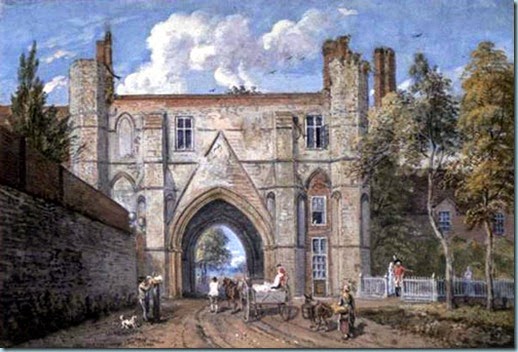Victoria here, reporting on a sidelight of our recent Duke of Wellington Tour…see multiple posts we have already published and will be covering in more depth in the next few months.
Neither Chawton nor Steventon was in my itinerary for my three weeks in England last summer, But wherever I went, I found bits of Austenalia at hand. I was surprised to see the shop closed, once Rohan’s, which filled the ground floor of Henry Austen’s former Henrietta Street house near Covent Garden.
The Blue Plaque marking Jane Austen’s visit was intact, but the building’s fate could not be determined in late August. If anyone hears what happens, please e-mail us!
Henrietta Street
Wandering through London, I found myself in Cheapside, where the Gardiners lived in Pride and Prejudice, and took the opportunity of visiting St. Mary-le-Bow.
St. Mary-le-Bow
To be a real Cockney, it is said, one must be born withing the sound of Bow Bells.
Altar, St. Mary-le-Bow
During London Open City Days, we toured the Foreign and Commonwealth Office Building, a place of many architectural wonders. In Dunbar Court, formerly the India Office, I found a statue of Warren Hastings, Governor-General of Bengal 1773-1785. Hastings is sometimes alleged to be the natural father of Jane Austen’s cousin, Elize de Feuillide, who named her only son after him.
Dunbar Court
Warren Hastings statue in Dunbar Court
Imagine my surprise when came upon the graves in Hamsptead of Eliza, her son, and her mother.
The gravestone, at St. John-at-Hampstead church, appeared tro be recently cleaned. It honors Philadelphia Hancock (d. 1792, age 61), her grandson Hastings (d. 1801, age six), and Elizabeth Austen (Eliza Hancock de Feuillide Austen), who was the wife of Jane’s brother Henry Austen. died at age 50 in 1813.
.
The lovely setting of the grave.
We visited Reading, in Berkshire, where we met author Beth Elliott, who is lucky enough to live nearby. Click here for her website and news of her books.
Beth Elliott, Author of Regency Tales
Beth kindly led us on a tour of the Forbury Gardens and the ruins of the Abbey.
Here, in the Abbey Gate, Jane Austen and her sister Cassandra attended a school about 1785.
Reading Abbey was founded in 1121 by King Henry I, youngest son of William the Conqueror. Igt was an important royal site for centuries until the Dissolution of the Monasteries by Henry VIII in 1539.
Considerable damage has occurred over the years, particularly from water. Currently, repairs are planned for the entire abbey complex, of which this is the only remaining intact building.
A fine series of carvings,called headstops, graced the building. I could not find identifications but one might assume they are kings, queens and saints????
18th Century view of the Abbey Gate before it was “tarted up” by Sir Gilbert Scott
in the Victorian era.
Authors and Austen lovers Diane Gaston, Beth Elliott and Victoria Hinshaw
Forbury Gardens overflowed with beautiful flower beds in the September sunshine.
A pretty view in which the trees block most of the construction.
Most of the ruins of Reading Abbey are currently fenced off and inaccessible. Repairs are underway.
The reddish tower, while picturesque, has nothing to do with the Abbey ruins!
Many of the nearby buildings were constructed of stones and rubble from the Abbey ruins.
Great Expectations, where Beth is fortunate enough to hold her critique group sessions.
After our day tramping around several estates then the Abbey ruins, we were delighted to retire with Beth Elliott to a local establishment for a little rest and relaxation.
My Austen Encounters were a great bonus to our Duke of Wellington tour, unforeseen but entirely welcome.




.jpg)
Another batch of delightful photos and accompanying notes, which depict your perambulations so vividly.
It's one of those linking circles of life that Jane Austen and the Duke of Wellington should have lived in the same area. You have put up a lovely selection of photos of Reading. The staff at the Great expectations will be very happy with your photo – I'll show them on my next visit.
Hi Beth. Give our best to the staff at Great Expectations! Just think how lucky you are to live in the tracks of the Duke and Jane Austen — not to mention loads of others. We'll be writing lots more about our trip, coming gradually, as we make it last as long as we can, re-living every moment.
Very interesting, and fun to see another of my interests (Jane Austen) celebrated! I was surprised to see you use the expression "tarted up"; I think of that as a very English expression, so I'd be interested to know if you were quoting Beth, or if it is an expression you use too!
You seem to have been very lucky in finding graves on this trip (I'm thinking of one of your earlier posts in this series).
Helena – Vicky wrote this post and yes, we commonly use English expressions without doing so intentionally. Vicky and I both spent a good deal of our time reading period materials – letters, documents, diaries, account books, so some of that has rubbed off on us. I had "I plight thee my troth" used in my wedding vows. My husand, who refused to read them before hand, stood before God and company when that was read out and said, "I plight what!?" I've been known to tell my kids that a certain thing might behoove them . . . I always us whilst, instead of while; going round the shops, etc etc. It must osmosis. Now all we have to do is get the accent down!